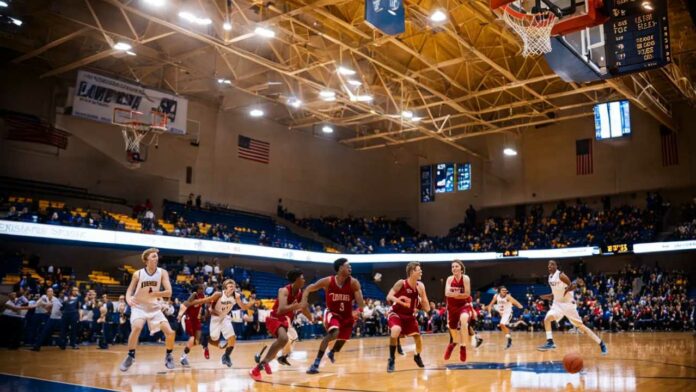High school basketball is a very popular sport and an important part of many communities. Whether you are a player, coach, or just watching the game, it is helpful to know how long is a high school basketball game. In this article, we will talk about how long these games usually last, the rules about game time, some history, and how it affects players and fans.
Regulation Length
A normal high school basketball game has four quarters. Each quarter is 8 minutes long for junior varsity and 10 minutes for varsity level. These rules are made by groups like the National Federation of State High School Associations (NFHS). Some states may have slightly different rules. But how long is a high school basketball game can also depend on other things that may make the game last longer than usual.
Halftime Break
At halftime, players and coaches get a short break to rest and plan for the rest of the game. This break usually lasts about 10 to 15 minutes. It gives players time to relax and coaches time to change their game plan if needed. During this time, there is often some entertainment to keep the crowd excited. Knowing how long is a high school basketball game includes understanding the length of halftime too.
Timeouts
Throughout the game, teams have the opportunity to call timeouts to pause play and discuss strategy. In high school basketball, teams are usually allowed a limited number of timeouts per game, with restrictions on when they can be called. These timeouts serve as crucial moments for coaches to provide guidance to players and make tactical decisions that could impact the outcome of the game.
Overtime
If the game is tied when the final buzzer sounds, the high school basketball game goes into overtime. This makes the game more exciting as both teams try to win. Each overtime period usually lasts 4 minutes. If the game is still tied, more overtime periods are played until one team wins. The exact rules can change depending on the league. So, when asking how long is a high school basketball game, overtime can make it longer than normal.
Factors Influencing Game Length
Many things can change how long is a high school basketball game. This includes how fast the game is played, how many fouls are called, and if there are any breaks for injuries or other reasons. If the game moves quickly with few stops, it may end on time. But if there are many fouls or delays, the game can take longer than usual.
Historical Perspective
How long is a high school basketball game has changed over the years. In the early days, games were shorter, with fewer quarters and longer breaks. As basketball became more popular and competitive, the rules were updated to match modern playing styles and standards. These changes helped shape the game we see today.
Strategies to Manage Time
Coaches play a crucial role in managing the duration of a high school basketball game, employing various strategies to optimize their team’s performance while staying within the allotted time frame. This may involve controlling the pace of play, utilizing timeouts strategically, and making substitutions to maintain player stamina throughout the game.
Audience Engagement
Keeping fans interested is very important for a high school basketball game. Loud and excited crowds make the game more fun and full of energy. To keep people happy and entertained, schools often plan fun shows, giveaways, and other activities during halftime. All these things are part of the full experience, just like knowing how long is a high school basketball game helps fans plan their time.
Impact on Players
How long is a high school basketball game can really affect the players, both in body and mind. Players need good stamina and energy to keep playing well the whole game. The pressure to win can also be stressful for their mental health. That’s why coaches need to make sure players train hard but also get enough rest, so they are ready for game day.
Comparison with Other Levels
The duration of high school basketball games differs from other levels of play, such as college or professional basketball. While the fundamental rules remain similar, variations in game length, timeouts, and overtime rules may impact the pace and intensity of play. Understanding these differences can provide valuable insights for players, coaches, and fans alike.
Community Involvement
High school basketball games are important events in many communities. They bring together students, families, and neighbors to cheer for their teams. Things like community events, fundraisers, and game-day traditions make the games more fun and special. Knowing how long is a high school basketball game helps everyone plan to enjoy the full experience together.
Future Trends
As high school basketball keeps changing, the rules and traditions about how long is a high school basketball game might change too. New technology, different ways of playing, and changes in what people like can affect how long games last. It’s important to follow these changes but also keep the true spirit of the game alive so it stays popular and successful.
Conclusion
In conclusion, the duration of a high school basketball game encompasses various factors that contribute to its overall experience. From regulation length and halftime breaks to timeouts and overtime periods, each aspect plays a crucial role in shaping the dynamics of the game. By understanding these intricacies, players, coaches, and fans can fully appreciate the excitement and intensity of high school basketball.
FAQS ( Frequently Asked Questions )
1. What is the standard duration of a high school basketball game?
A standard high school basketball game consists of four quarters, each lasting eight to ten minutes, depending on the level of play.
2. Can a game extend beyond regulation time?
Yes, if the score is tied at the end of regulation, the game may go into overtime to determine a winner.
3. How long is halftime in high school basketball?
Halftime typically lasts around ten to fifteen minutes, providing players and coaches with a brief break to regroup and strategize.
4. Are there rules regarding timeouts?
Yes, teams are usually allowed a limited number of timeouts per game, with restrictions on when they can be called.
5. How do coaches manage game duration?
Coaches employ various strategies, such as controlling the pace of play and utilizing timeouts strategically, to manage the duration of a high school basketball game

